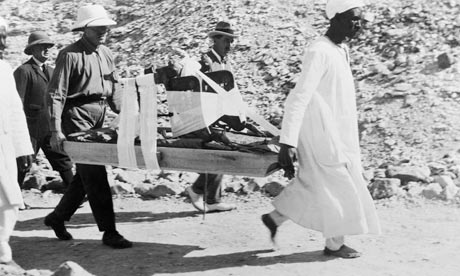
A seizure of power by the Egyptian army – 34 centuries ago
Toby Wilkinson
guardian.co.uk
Howard Carter watches as porters carry a throne from Tutankhamen's tomb in 1923. Photograph: Bettmann/CORBIS
Among the manifold treasures of Tutankhamen's tomb, "the only thing missing", as Joyce Tyldesley notes in her new book, "was a library". The boy-king need not have worried: Egyptologists and others have more than made up for that deficiency in the 90 years since the discovery of the pharaoh's gilded sepulchre in the Valley of the Kings.
A quick search for "Tutankhamen" in my local library catalogue reveals no fewer than 115 titles. One might be tempted to ask "Do we really need another book?" By writing one, Tyldesley succumbs to one of the most pernicious of Tutankhamen's curses: in her own words, "the fixation that the general public, thoroughly egged on by the media, has developed with the king at the expense of the rest of Egypt's long history". His celebrity may be illogical, but it is irresistible.
Perhaps in an attempt to distance itself from "Tut-mania", Tyldesley's book underwent a subtle re-positioning between press release and publication. Its original, stirring subtitle, "The Development of a Legend", was amended to the anodyne "The Developing History of an Egyptian King". But this merely illustrates another of the boy-king's curses: as Tydesley remarks wryly, "writing about Tutankhamen may be interpreted as a venal attempt to make money, which, in the world of academia, has not always been seen as a good thing".
Whether a shameless attempt to cash in on the young pharaoh's most recent worldwide tour or a genuine effort to contribute something original to an already well-told story, Tutankhamen's Curse suffers from another common affliction in Egyptology: the uneasy tension between populism (Tyldesley's "three crucial clues to Tutankhamen's whereabouts") and academic rigour (an obstruse, if unavoidable, discussion of ancient Egyptian royal names). On the whole, though, she gets the balance about right and the book is both solidly researched and accessibly written.
The range of topics covered is impressive: from the history of excavation in the Valley of the Kings (quotations from early 20th-century letters and newspaper cuttings illustrate the cut-throat world of archaeology) to questions about Tutankhamen's parentage (with no fewer than eight potential candidates for his mother). But another of Tutankhamen's curses is all too apparent – nothing here is new. As Tyldesley herself admits, it is "not possible to tell the full and accurate story of Tutankhamen's life and death. There are still too many unanswered questions, too many blank areas". As a result, competing theories are referred to but left unresolved. Should we favour the traditional, historical reconstruction of Tutankhamen's family background or the results of new DNA fingerprinting? Tyldesley instinctively favours the former – displaying another curse of Egyptologists, the preference for texts over science – but ultimately she does not commit herself, hampered by the intractability of the scant and contradictory evidence.
Tutankhamen's own curse was his early death. But the curse everyone picking up this book will expect to read about is the fate that supposedly befell those who disturbed his eternal rest. Here, Tyldesley is on firmer ground and in fine narrative form. She recounts the various personal and family disasters that have been attributed to the pharaoh's displeasure, before noting, with relish, that Douglas Derry, "the man who did most physical damage to Tutankhamen, died aged 87 in 1969". Howard Carter, the first human in 33 centuries to enter his tomb, did suffer a curse of sorts – the unwanted fame that the discovery brought him, and the effective end of his career.
In her final chapter, Tyldesley notes the profound effect that ancient Egyptian myths have had on 20th century western culture, and how they continue to populate today's blogosphere.
Yet the aspect of Tutankhamen's story that surely has the most contemporary resonance receives no mention. Throughout his reign, real power was exercised by the Egyptian army. The power behind Tutankhamen's throne was the self-styled "general of generals", Horemheb. The army's fingerprints are all over Tutankhamen's "restoration decree", in which the "heresies" associated with Tutankhamen's own father are publicly renounced and the conservative forces of counter-revolution triumphantly reasserted.
Following Tutankhamen's death and with no surviving heirs, the army moved swiftly to secure its grip on the levers of state. The succession passed first to a superannuated chariotry officer, Ay, then, a few years later, to General Horemheb – who rewrote the record to present himself as the first legitimate ruler in three generations, and systematically usurped Tutankhamen's monuments in an attempt to expunge his erstwhile boss from the pages of history.
Horemheb's much-vaunted new dawn was nothing of the sort, and Egypt was destined to be ruled by generals for the next 150 years. Once it had tasted power, the army proved almost impossible to dislodge.
For the Egyptians who crowded into Cairo's Tahrir Square a year ago to call for the end of military dictatorship and who continue to die on the city's streets in defence of democracy, that particular aspect of the king's legacy remains Tutankhamen's real curse.
• Toby Wilkinson's The Rise and Fall of Ancient Egypt is published by Bloomsbury.
http://www.guardian.co.uk/culture/2012/feb/24/tutankhamens-curse-joyce-tyldesley-review?newsfeed=true
No hay comentarios:
Publicar un comentario